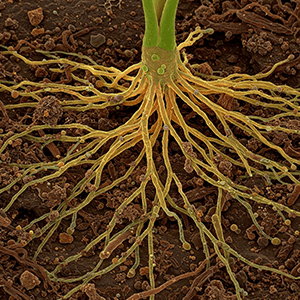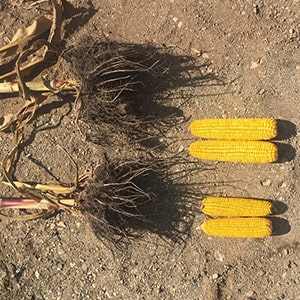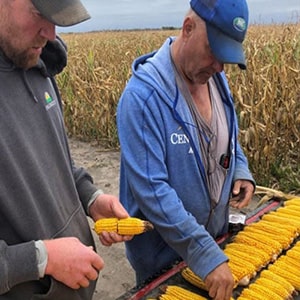AMF: Keeping Soil Alive for The Next Generation of Agriculture
Soil health is the #1 thing growers should be focusing on to make their farm more profitable. The reason we founded our company, New Age Farming LLC (est: 2010), was to solve the problem of degrading soil in agriculture. I grew up farming in southeast North Dakota and saw the first-hand effects of how chemicals and traditional farm practices have been degrading our soil over time. AMF is one of the most promising “technologies” available to growers to help restore balance to their fields. But what are AMF? We will begin with a definition.
What are AMF?
Arbuscular Mycorrhizal Fungi (AMF) are microbial fungi, commonly found in healthy soils that are symbiotic with most crops we grow. AMF are living extensions of the roots, increasing the root rhizosphere and surface area by many times. The plants feed carbohydrates to the AMF, which in turn helps the fungi access water, phosphorus, nitrogen, potassium, and micronutrients for the plant.

Why is AMF Used in Agriculture?
The use of AMF as a growing tool is one of the most important and innovative techniques in the 21st century. It’s becoming more well-known that the overuse of fertilizers, chemicals, salts, and tillage in agriculture has severely harmed the quality of the soil. The reduction in the health of the soil leads to increased use of artificial methods to gain additional yield from the ground. This has caused a very bad spiral of fixing the symptom with solutions that become the problem. Inoculating with AMF is a way to introduce more organic, healthy methods of soil repair, while still maintaining yields and decreasing fertilizer requirements. AMF allows growers to get their soil microbiome closer to what soil looked like 200+ years ago. This is what cover-croppers and no-tillers are striving for. As growers begin to adopt the use of fungi in their planting strategies, we will see the soil getting balanced, healthier, and conserved for generations. This is the ultimate reason for using AMF: soil conservation.

Using AMF in the New Playbook for Ag Sustainability
Replacing Chemical Fertilizers
As we alluded to before, chemical fertilizers have been increasingly used since the end of the 20th century into the 21st century farming. The reason growers use these fertilizers is the ability to get consistent and predictable yields out of their crops. It’s a mathematical equation that uses the soil as a blank canvas, and growers can treat the soil as an equation.
These chemical fertilizers come with a downside. They strip the soil of its natural PH and microbiome, causing the soil to be essentially barren without the use of interventions like fertilizers. This causes a very bad feedback cycle: the soil becomes more barren, and thus more fertilizers and chemicals are needed to maintain the expected yield. This goes on for many growing cycles, all while the soil is becoming increasingly depleted. Crops can only absorb around 40% of the total Inorganic fertilizers applied. This causes both waste for the growers’ budget and leads to pollution in rivers and lakes. With AMF in the equation, crops can now absorb substantially more than a mere 40% of the fertilizer applied.
Crops can only absorb around 40% of the total Inorganic fertilizers applied. This causes both waste for the growers’ budget and leads to pollution in rivers and lakes.
AMF allows growers to cooperate with the soil, rather than parasitically extract resources from the soil.
AMF helps the soil with nutrient cycling, water retention, and chemical tie-ups. They play a part in the overall soil food web that involves plants, organic matter, arthropods, nematodes, bacteria, and other life forms. An excellent video to help you understand how nutrient cycling works is embedded below. It was produced by Dr. Elaine Ingham, who is the author of the USDA’s Soil Biology Primer.
Growing Nutrient-Dense Food
AMF is part of improving the nutrient cycle, and thus helps create more nutrient-dense food. Our food has become less nutrient-dense over time, which is directly attributable to the decrease in solid quality. Soil scientists have started pointing to studies where issues with nutrition were attributed to a disruption in normal biological processes in nature. Plants grown in soil with biologically active soil levels did not have lower nutrient values, according to a study referenced by California State University Chico.
Another study was done to examine the nutrient content over time of 43 vegetable and fruit crops. The researchers found a 9-38% decline in six of the 13 nutrients studied between the years 1950 to 1999. (Donald Davis of the Biochemical Institute at the University of Texas in Austin) https://www.csuchico.edu/regenerativeagriculture/blog/nutrient-density.shtml
Nutrient density in soil affects the nutrient density in food. AMF plays a critical role in the nutrient cycle of soil, which is why we observe much larger yields in growers who use mycorrhizal fungi products.
Water Management & Drought Resistance
AMF is used as a water management method in regenerative ag. Since it affects the properties of the soil, it can actually improve water infiltration. AMF can also extend a plant’s root surface area, which allows for easier water uptake. Researchers have even used AMF to improve water purity in constructed wetlands.
Another huge benefit of AMF is the ability to be drought-resistant. Since plants have a higher absorption efficiency when AMF is present, it reduces the amount of water needed to grow plants. A scientific report published in April 2025 showed AMF was a critical player in improved rice yields under limited irrigation conditions.
Soil Structure
Growers have been increasingly concerned about soil structure. The rise of “no till” agriculture and regenerative techniques has focused on ways to prevent the destruction of natural soil conditions and improve the microbiome.
AMF’s hyphae actually help in the formation and stability of soil aggregates. A scholarly article published by researchers at Universidad de La Frontera in Chile posited in their abstract that “Hyphae of arbuscular mycorrhizal fungi (AMF) are considered to be primary soil aggregators and there is a positive correlation between AMF hyphae and aggregate stability in natural systems”. Soil aggregation is essential for proper land use management and facilitating biogeochemical cycling. The hyphe also have penetrating pressures that alleviate compaction issues.
Resistance to Heavy Metals
Metals in soil have become a huge problem for ag around the world, especially with the use of pesticides and fertilizers containing metals and metalloids. This can cause imbalances to the biogeochecmical cycles, and thus have an impact on plant and human health. Interestingly, AMF naturally survives on high levels of metal(loid)s and can help the host plant withstand the contaminants.
In other words, AMF can be used to detoxify soil and food, making our food supply much cleaner and safer for humans.
AMF has been shown to help plants in resistance to toxic heavy metals found in soil. A part of the symbiosis process between the host plant and AMF, the fungi can help reduce the oxidative stress caused by heavy metals by improving the plant’s ability to absorb mineral nutrients [NIH].
Practical Strategies for Growers
While AMF is excellent in theory, this really only matters if growers have an easy way to include it in their ag strategy. AMF is not a fix-all, but a large part of an overall regenerative growth strategy. A few of the things we prescribe when we are on the phone with farmers are below.

Reduce Tilling or Shallow Tillage
Tilling soil disrupts the hyphal networks of AMF. With AMF living predominantly in the top 2-10 inches of soil, it’s critical to implement minimal or shallow till practices. The NIH published a scientific research article on how tillage practices can change mycorrhizal fungi populations during crop growth.
Some recommendations for growers in semi-arid regions that are inferred in this study:
- No-Tillage with Mulch – This practice consistently positively affected the AMF community, increasing the abundance of beneficial genera like Glomus and Septoglomus. These fungi are known to enhance nutrient uptake and potentially improve plant resilience. Leaving crop residue on the soil surface can also help conserve moisture.
- Subsoiling with Mulch – Similar to no-till, subsoiling breaks up compacted layers in the soil to help water infiltration and root growth. The mulch is designed to be a soil cover. This can be a good option for fields with soil compaction issues.
Cover Crops
Cover crops are a good way to keep beneficial fungi in the soil. Barley or Rye, in particular, are a good cover crop for a main crop like beans. A study done over ten years found that using barley as a winter cover crop appeared to be the best option for encouraging healthy AMF populations and overall biological activity in soil.
Crop Rotation
Rotating crops is another strategy for boosting AMF in your soil. Research shows that growing chickpeas before wheat can help the wheat form a better partnership with beneficial soil fungi (AMF), leading to higher yields.
Smart Fertilization
Excessive phosphorus can have a very negative impact on the AMF-plant symbiosis. As you start using AMF inoculents in your soil, it’s important to start reducing the volume and type of fertilizer used on your fields. This is essential, even if you are employing other strategies on this list, like cover crops and crop rotation.
Inoculant Selection
Our business is built on helping growers select the best AMF inoculant for their situation. The main difference between most of our products is the delivery system and certification levels.
Our main product is MycoMaxx, which is an all-around go-to for growers using in-furrow applications with startup fertilizers. It also serves as the basis for our entire MycoMaxx product line. MycoMaxx OMRI is the same eight-species AMF, but formulated to fit OMRI certification guidelines. MycoMaxx Plus adds carefully selected bacteria to the formulation to help with mineral and nutrient uptake. If you use seed treating equipment, MycoMaxx ST and MycoMaxx ST Plus. A unique product for orchards is MycoMaxx Orchard, which uses a selection of endo and ecto mycorrhizal fungi and bacteria to help boost macro and micro nutrients.
New Age Farming LLC was established in 2010 with the sole focus on Arbuscular Mycorrhizal Fungi for agriculture. We were the only company at the time with the AMF vision. Since that time other companies have dabbled with mycorrhizae usually at a low spore count and low species diversity, which just doesn’t work in our soils. While there are some other AMF inoculants on the market, growers tend to appreciate the quality, no-hassle results of MycoMaxx.
A Soil for the Future
Conventional agriculture’s reliance on synthetic fertilizers and intensive tillage has compromised the very foundation of its success: healthy, living soil. The degradation of soil quality has created a self-perpetuating cycle of dependence on artificial interventions, often at the expense of long-term sustainability. AMF offers a way to break this cycle and restore balance in the soil.
Growers can embrace AMF and begin integrating these beneficial fungi using no-till methods and inoculants. Our generation can cultivate healthier soils, more resilient crops, and a more sustainable agricultural system for the future. We want the land to remain a living, productive resource for our children.
